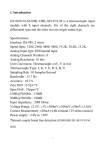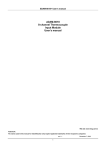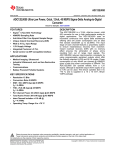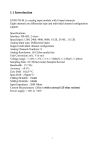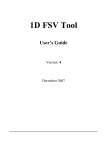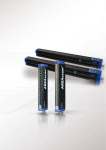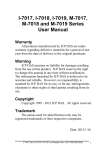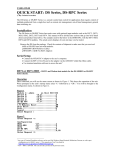Download eDAM-8018 8-channel Analog Input Module User's manual
Transcript
EDAM-8018 User’s manual
eDAM-8018
8-channel Analog Input Module
User’s manual
Web site: www.inlog.com.tw
Trademark:
The names used in this manual for indentification only maybe registered trademarks of their respective companies
rev 1.6
1
July 11, 2011
EDAM-8018 User’s manual
Table of Contents
Chapter 1 Introduction ·······················································································································································4
1.1
1.2
1.3
1.4
1.5
1.6
Overview ··················································································································································4
Module Compatibility································································································································4
Communication and Programming···········································································································4
Software Configuration and Calibration····································································································4
Watchdog Timer ·······································································································································4
Power Requirements································································································································4
Chapter 2 About the eDAM Analog Modules ····················································································································5
2.1
2.2
2.3
2.4
2.5
2.5.1
2.5.2
Outline of eDAM Analog modules ············································································································5
Module Dimension ···································································································································5
eDAM-8018 module ·································································································································7
Block diagram of modules ························································································································8
Wire connection ·······································································································································8
EDAM-8018 wire connection····················································································································8
EDAM8018 pin assignments ····················································································································9
Chapter 3 Installation ·························································································································································10
3.1
3.2
3.3
3.4
3.5
3.6
3.7
3.8
3.9
Set up an eDAM network ·························································································································10
Host computer··········································································································································10
Power supply············································································································································10
Communication Wiring ·····························································································································10
eDAM Utility Software ······························································································································11
eDAM Isolated RS-232/RS485 Converter································································································11
Initializing a Brand-New Module···············································································································11
Initialization Procedure·····························································································································11
Install a New eDAM to a Existing Network ·······························································································12
Chapter 4 ASCII Command Set··········································································································································13
4.1
4.2
4.3
4.4
4.5
4.6
4.7
4.8
4.8.1
4.8.2
4.8.3
4.8.4
4.9
4.9.1
4.9.2
4.9.3
4.9.4
4.9.5
4.9.6
4.9.7
4.9.8
4.9.9
4.9.10
4.9.11
4.9.12
4.9.13
4.9.14
4.9.15
4.9.16
4.9.17
4.9.18
4.9.19
Introduction ··············································································································································13
Format of eDAM Commands ···················································································································13
Calculate Checksum: ·······························································································································13
Response of Commands··························································································································14
Summary of Command Set ······················································································································14
Host Watchdog Command Sets ···············································································································14
General Command Sets···························································································································14
Configuration Tables ································································································································14
Baud rate setting (CC) ·····························································································································14
Analog Input Type Setting (TT) ················································································································15
Data Format Setting (FF) ·························································································································15
Analog Input Type and Data Format Table ·······························································································16
Command description ······························································································································17
%AANNTTCCFF Set Module Configuration·····························································································17
#AA
Read analog data ···············································································································17
#AAN
Read analog input from channel N ·····················································································18
$AA0
Span calibration ··················································································································18
$AA1
Offset calibration·················································································································18
$AA2
Read configuration status ···································································································19
$AA3
Read cold junction temperature ··························································································19
$AA5VV
Enable/disable channels for multiplexing············································································20
$AA6
Read channel status ···········································································································20
$AA7CiRrr Set channel type individually ······························································································21
$AA8Ci
Read individual channel type······························································································21
$AA9
Read CJC Offset·················································································································21
$AA9snnnn Set CJC Offset Value ··········································································································22
$AAB
Read channel burnout status······························································································22
~AACe
Enable/disable cold junction compensation (CJC)······························································22
$AAF
Read firmware version········································································································23
$AAM
Read module name ············································································································23
$AAP
Read the communication protocol ······················································································23
$AAPN
Set the communication protocol ·························································································24
2
EDAM-8018 User’s manual
4.9.20
4.9.21
4.9.22
4.9.23
4.9.24
4.9.25
4.9.26
~AAEV
Enable/disable module calibration ······················································································24
~AAO(name) Set module name ···············································································································24
~AA0
Read the host watchdog status···························································································25
~AA1
Reset the host watchdog time out status ············································································25
~AA2
Read the host watchdog time out value··············································································25
~AA3EVV
Enables/disables the host watchdog···················································································26
~**
Sends a “Host OK”··············································································································26
Chapter 5 MODBUS RTU Command structure ·················································································································27
5.1
5.2
5.2.1
5.2.2
5.2.3
5.2.4
5.3
5.4
MODBUS Function code introductions·····································································································27
MODBUS Address Mapping·····················································································································28
Discrete coil address································································································································28
Discrete input address ·····························································································································28
Input register address ······························································································································29
Holding register address ··························································································································30
MODBUS Engineering Data Format Table ·······························································································31
MODBUS Hex 2’s complement Data Format Table··················································································31
Chapter 6 Calibration for eDAM8018·································································································································32
3
EDAM-8018 User’s manual
Chapter 1 Introduction
1.1 Overview
The eDAM-8000 analog modules is a set of intelligent sensor to computer interface modules containing built-in
microprocessor. They provide data comparison, and digital communication functions. Some modules provide analog I/O lines
for controlling and monitoring analog signals.
1.2 Module Compatibility
The eDAM-8000 series are fully compatible to Advantech® ADAM-4000 series, ADlink® NμDAM-6000 series and ICP®
I-7000 series by Command “~AA2X01V”
1.3 Communication and Programming
eDAM modules can connect to and communicate with all computers and terminals. They use RS-485 transmission standards,
and communicate with ASCII format commands. All communications to and from the module are performed in ASCII, which
means that eDAM modules can be programmed in virtually any high-level language.
Up to 256 eDAM modules may be connected to an RS-485 multi-drop network by using the eDAM RS-485 repeater,
extending the maximum communication distance to 4,000 ft.
1.4 Software Configuration and Calibration
EDAM modules contain no pots or switches to set. By merely issuing a command from the host computer, you can change an
analog input module to accept several ranges of voltage input.
Remote configuration can be done by using the command set’s configuration and calibration commands.
By storing configuration and calibration parameters in a nonvolatile EEPROM, modules are able to retain these parameters in
case of power failure.
1.5 Watchdog Timer
A watchdog timer supervisory function will automatically reset the eDAM modules in the event of system failure. Maintenance
is thus simplified.
1.6 Power Requirements
Although the modules are designed for standard industrial unregulated 24V DC power supply , they accept any power unit
that supplies power within the range of +10 to +30 V DC . The power supply ripple must be limited to 5 V peak-to-peak, and
the immediate ripple voltage should be maintained between +10 and +30 V DC .
4
EDAM-8018 User’s manual
Chapter 2 About the eDAM Analog Modules
2.1 Outline of eDAM Analog modules
2.2 Module Dimension
5
EDAM-8018 User’s manual
6
EDAM-8018 User’s manual
2.3 eDAM-8018 module
eDAM-8018 is a thermocouple input module with 8 input channels. Six of the eight channels are differential type and the other
two are single ended type.
Specifications of eDAM-8018
Interface: RS-485, 2 wires
Speed (bps): 1200, 2400, 4800, 9600, 19.2K, 38.4K , 115.2K
Analog Input type: Differential input
Analog Channels Numbers: 8
Analog Resolution: 16 bits
Unit Conversion: Thermocouple, mV, V or mA
Thermocouple Type: J, K, T, E, R, S, B, N
Sampling Rate :10 Samples/Second
Bandwidth : 15.7 Hz
Accuracy : ±0.1%
Zero Drift : 0.5µV/°C
Span Drift : 25ppm/°C
CMR@50/60Hz : 150dB
NMR@50/60Hz : 100dB
Input Impedance : 20M Ohms
Voltage Range: ±2.5V, ±1V,±500mV,±100mV, ±50mV, ±15mV
Current Measurement: ±20mA (with external 125 ohms resistor)
Power supply: +10V to +30V
7
EDAM-8018 User’s manual
2.4 Block diagram of modules
eDAM-8018
+5V
CJ
Power
Vin 0+
Vin 0-
LED indicator
Vin 1+
Photo-Isolation
INIT
Micro
processor
Vin 1ADC
(EEPROM)
Data+
DataVS
GND
RS-485
interface
Vin 2+
Vin 2-
Vin 7+
Vin 7+5V
Power
supply
Isolated
Power
2.5 Wire connection
2.5.1 EDAM-8018 wire connection
Differential analog input for channel 0 to channel 7
Vin x+
Vin x-
Vin x+
+
V
-
I
Vin x-
+
-
Analog input mode for channel 6 can channel 7 can be selected by setting JP1 on the board
Differential input channel 6 and 7
Single-ended input channel 6 and 7
JP1
JP1
Vin 6+
Vin 6+
Vin 6-
+
+
V
-
Vin 6-
V-
V
Vin 7+
Vin 7+
Vin 7/INIT
+
V
-
Vin 7/INIT
8
+
EDAM-8018 User’s manual
2.5.2 EDAM8018 pin assignments
pin
1
2
name
Vin5+
Vin5-
description
Differential positive input channel 5
Differential negative input channel 5
3
4
Vin6+
Vin6-/AGND*
5
6
Vin7+
Vin7-/INIT**
Differential/single-ended input channel 6
Differential negative ground of channel 6 or AGND for single-ended input
channel 6 & 7
Differential/single-ended input channel 7
Differential negative ground of channel 7 or Initial state setting
7
8
9
10
11
12
13
14
15
16
17
18
19
DATA+
DATA+VS
GND
Vin0+
Vin0Vin1+
Vin1Vin2+
Vin2Vin3+
Vin3Vin4+
signal, positive
signal, negative
+10V ~ +30Vdc
Ground
Differential positive input channel 0
Differential negative input channel 0
Differential positive input channel 1
Differential negative input channel 1
Differential positive input channel 2
Differential negative input channel 2
Differential positive input channel 3
Differential negative input channel 3
Differential positive input channel 4
20
Vin4-
Differential negative input channel 4
Negative input of channel 6 or common AGND of channel 6 and 7 depended on JP1 setting (see page 8)
** Negative input of channel 7 or INIT (Initial state setting) pin
9
EDAM-8018 User’s manual
Chapter 3 Installation
This chapter provides guidelines to what is needed to set up and install an eDAM network. A quick hookup scheme is
provided that lets you configure modules before they are installed in a network.
To help you to connect eDAM modules with sensor inputs, several wiring examples are provided. Finally, you will find at the
end of this chapter a programming example using the eDAM command set.
Be sure to carefully plan the layout and configuration of your network before you start. Guidelines regarding layout are given
in Appendix E: RS-485 Network.
NOTICE: Except for changing eDAM to other compatible modules, which have on-board switches for their baud rate setting,
eDAM modules should not be opened. There is no need to open the eDAM modules: all configuration is done remotely and
there are no user serviceable parts are inside. Opening the cover will therefore void the warranty.
3.1 Set up an eDAM network
The following list gives an overview of what is needed to setup, install and configure an eDAM environment.
A host computer that can output ASCII characters with an RS-232C or RS-485 port.
Power supply for the eDAM modules (+10 to +30 V DC )
eDAM Series Utility software
3.2 Host computer
Any computer or terminal that can output in ASCII format over either RS-232 or RS-485 can be connected as the host
computer. When only RS-232 is available, an eDAM-8520 module (RS-232/RS-485 converter) is required to transform the
host signals to the correct RS-485 protocol. The converter also provides opto-isolation and transformer-based isolation to
protect your equipment.
For the ease of use in industrial environments the eDAM modules are designed to accept industry standard +24 VDC
unregulated power. Operation is guaranteed when using any power supply between +10 and +30 VDC. Power ripples must be
limited to 5 V peak to peak while the voltage in all cases must be maintained between +10 and +30 VDC . All power supply
specifications are referenced at module connector. When modules are powered remotely, the effects of line voltage drops
must be considered.
3.3 Power supply
All modules use on-board switching regulators to sustain good efficiency over the 10-30V input range, therefore we can
assume that the actual current draw is inversely proportional to the line voltage. The following example shows how to
calculate the required current that a power supply should be able to provide.
3.4 Communication Wiring
We recommend that shielded-twisted-pair cables that comply with the EIA RS-485 standard be used with the eDAM network
to reduce interference.
10
EDAM-8018 User’s manual
3.5 eDAM Utility Software
A menu-driven utility program called “DOSEDAM.EXE” for DOS or “WINEDAM.EXE for Windows is provided for eDAM
module configuration, monitoring and calibration. It also includes a terminal emulation program that lets you easily
communicate through the eDAM command set
3.6 eDAM Isolated RS-232/RS485 Converter
When the host computer or terminal has only a RS-232 port, an eDAM-8520 Isolated RS-232/RS-485/422 converter
connected to the host’s RS-232 port is required.
This module equips a “Auto baud rate detector” inside, therefore it can detect the baud rate and data format automatically and
control the direction of RS-485 precisely
3.7 Initializing a Brand-New Module
All eDAM modules in a RS-485 network must have an unique address ID. Therefore, to configure the brand-new 8012/D,
8014/D, 8018 before using is necessary
Factory default settings:
Address ID is 01
Baud rate is 9600 bps, check-sum disable
Analog input type: Type 08 (±10V)
60Hz filter rejection mode
Normal operation mode (for 8012/D, 8018)
Six differential and 2 single-ended input mode (for 8018)
INIT* State settings:
The eDAM I/O modules must be set at INIT* State when you want to change the default settings, such as the ID address,
baud rate, check-sum status etc. All eDAM I/O modules have an special pin labeled as INIT*. The module will be in Default
State if the INIT* pin is shorted to ground when power ON. Under this state, the default configuration is set as following:
Address ID is 00
Baud rate is 9600 bps
Check-sum disable
Therefore, the communication between host and the module will can be easily set as the same configuration, the
initialization of a module will be possible no matter what configuration is set under operating state.
3.8 Initialization Procedure
1.
Power off the host computer and the installed eDAM-8520 to COM port of host computer.
2.
Connect a brand new eDAM module with the RS-485. Set the module in Default State by shorting the INIT*
pin to GND. Refer to Figure 4.1 for detailed wiring.
3.
Power on the power supply for eDAM modules.
4.
Use the eDAM utility to configure the address ID, baud rate, check-sum status and command sets of the
module.
eDAM8520
HOST PC RS-232C
TX 3
RX 2
5
GND
3 TX
2 RX
5 GND
Data+
Data-
eDAM I/O module
RS-485
VS
GND
Data+
Data-
INIT
VS
GND
GND
Power supply
VS 10Vdc-30Vdc
Figure 4.1
11
EDAM-8018 User’s manual
3.9 Install a New eDAM to a Existing Network
1.
Equipments for Install a New Module
2.
A existing eDAM network
3.
New eDAM modules.
4.
Power supply (+10 to +30 VDC)
5.
Installing Procedures
6.
Configure the new eDAM module according to the initialization procedure in section 3.7
7.
The baud rate and check-sum status of the new module must be identity with the existing RS-485 network.
The address ID must not be conflict with other eDAM modules on the network.
8.
Power off the eDAM power supply of the existing RS-485 network.
9.
Wire the power lines for the new eDAM with the existing network. Be careful about the signal polarity as
wiring.
10. Wire the RS-485 data lines for the new eDAM with the existing network. Be careful about the signal polarity
as wiring.
11. Wire to the input or output devices.
12. Power on the eDAM local power supply.
13. Use the eDAM utility to check entire network.
12
EDAM-8018 User’s manual
Chapter 4 ASCII Command Set
4.1 Introduction
The eDAM command is composed by numbers of characteristics, including the leading code, address ID, the variables, the
optional check-sum byte, and a carriage return to indicate the end of a command.
The host computer can only command only one eDAM module except those synchronized commands with wildcard address
command “#**”. The eDAM may or may not give response to the command. The host should check the response to
handshake with the modules.
4.2 Format of eDAM Commands
Syntax: (Leading code)(Addr)(Command)[Data] <Cksum><CR>
Every command begins with a delimiter character. There are five valid characters: a dollar sign $, a pound sign #, a
percentage ,a wave sign ’~’ ,sign % and an at sign @.
The delimiter character is followed by a two-character address (hexadecimal) that specifies the target module. The actual
two character command follows the address. Depending on the command, an optional data segment follows the command
string. An optional two character checksum may be appended to the total string. Every command is terminated by a
carriage return (cr).
Conventions
Leading Code
The first characteristic of the eDAM command, such as %,$,#,~,
@, …etc(1- character)
Addr
Module’s address ID, the value is in the range of
00 – FF (Hex) 2- character
Command
Command codes or value of variables
Data
Data needed by some output command
Checksum
Checksum in brackets indicate optional parameter, only
checksum is enable then this field is required (2- character)
<CR>
carriage return( 0x0D)
Note:
all commands should be issued in ASCII uppercase characters. There is no spacing
between characters.
4.3 Calculate Checksum:
1.
Calculate ASCII sum of all characters of command (or response) string except the character return(cr)
2.
Mask the sum of string with 0ffh
3.
[Checksum]={(Leading code)+(addr)+(command)+[data]} MOD 0x100
Example:
Command string : $012(cr)
Sum of string=’$’+’0’+’1’+’2’=24h+30h+31h+32h=B7h
The checksum is B7h, and [CHK]=”B7”
Command string with checksum=$012B7(cr)
Response string : !01400600(cr)
Sum of string=’!’+’0’+’1’+’4’+’0’+’0’+’6’+’0’+’0’
=21h+30h+31h+34h+30h+30h+36h+30h+30h=1Ach
The checksum is Ach, and [CHK]=”AC”
Response string with checksum=!01400600AC(cr)
13
EDAM-8018 User’s manual
4.4 Response of Commands
The response message depends on eDAM command. The response is also composed with several characteristics, including
leading code, variables, and carriage return for ending. There are two kinds of leading code for response
message, ”!“ or ”>“ means valid command and ”?“ means invalid. By checking the response message, user can monitor the
command is valid or invalid.
But under the following conditions, there will have no response message.
The specified address ID does not exist.
Syntax error or communication error
Some special commands does not have response.
4.5 Summary of Command Set
There are four categories of eDAM commands. The first is the eDAM special commands. The second is the general
commands, The third is the analog commands., the forth is the digital commands and the last is linear mapping
commands. All the commands used in the eDAM analog input module are list in the following table.
4.6 Host Watchdog Command Sets
Command
~**
Response
no response
Description
Host OK
Sec.
4.9.26
~AA0
~AA1
~AA2
~AA3EVV
!AASS
!AA
!AAVV
!AA
Read Module Status
Reset Module Status
Read Host watchdog Timeout Value
Set Host Watchdog Timeout Value
4.9.22
4.9.23
4.9.24
4.9.25
4.7 General Command Sets
Command
Description
Sec.
%AANNTTCCFF !AA
Response
Set Module Configuration
4.9.1
#AA
#AAN
$AA0
$AA1
$AA2
$AA3
$AA5VV
$AA6
>(Data)
>(Data)
!AA
!AA
!AATTCCFF
>(Data)
!AA
!AAVV
Read Analog Input
Read Analog Input from channel N
Perform Span Calibration
Perform Zero Calibration
Read Configuration
Read cold junction temperature
Set Channel Enable
Read Channel Status
4.9.2
4.9.3
4.9.4
4.9.5
4.9.6
4.9.7
4.9.7
4.9.9
$AA7CiRrr
!AA
Set channel type individually
4.9.10
$AA8Ci
!AACiRrr
Read individual channel type
4.9.11
$AA9
!AA(Data)
Read CJC Offset
4.9.12
$AAB
$AA9SNNNN
$AAP
$AAPn
~AACN
~AAEV
~AAO(Data)
!AA(Data)
!AA
!AASC
!AA
!AA
!AA
!AA
Read channel burn out status
Set CJC Offset Value
Read communication protocol
Set communication protocol
Enable/disable CJC
Enable/Disable Calibration
Set Module Name
4.9.14
4.9.13
4.9.18
4.9.19
4.9.15
4.9.20
4.9.21
4.8 Configuration Tables
4.8.1 Baud rate setting (CC)
Code (CC)
03
04
05
06
07
08
09
0A
Baud rate
1200
2400
4800
9600
19200
38400
57600
115200
Note: The data bits are fixed at one start bit, eight data bits, no parity and one stop bit
14
EDAM-8018 User’s manual
4.8.2 Analog Input Type Setting (TT)
Input Range Type(Hex)
00
08
09
0A
0B
0C
0D
Input Range
No change
± 10 V
±5V
±1V
± 500 mV
± 150 mV
± 20 mA
4.8.3 Data Format Setting (FF)
7
6
FS
5
CS
4
3
2
reserved
Description
CS
FS
0
DF
Key
DF
1
Data format
00: Engineer unit
01: % of FSR (full scale range)
10: 2’s complement hexadecimal
Check sum
0: disabled
1: enabled
Filter settings
0: 60 Hz rejection
1:50 Hz rejection
15
EDAM-8018 User’s manual
4.8.4 Analog Input Type and Data Format Table
Code
Range
00
-15~+15mV
01
-50~+50mV
02
-100~+100mV
03
-500~+500mV
04
-1~+1V
05
-2.5~+2.5V
06
-20~+20mA
OE
Type J T/C
-210~760°C
0F
Type K T/C
-270~1372°C
10
Type T T/C
-270~400°C
11
Type E T/C
-270~1000°C
12
Type R T/C
0~1768°C
13
Type S T/C
0~1768°C
14
Type B T/C
0~1820°C
15
Type N T/C
-270~1300°C
Format
+F.S.
Engineer unit
% of F.S.R
2’s complement
Engineer unit
% of F.S.R
2’s complement
Engineer unit
% of F.S.R
2’s complement
Engineer unit
% of F.S.R
2’s complement
Engineer unit
% of F.S.R
2’s complement
Engineer unit
% of F.S.R
2’s complement
Engineer unit
% of F.S.R
2’s complement
Engineer unit
% of F.S.R
2’s complement
Engineer unit
% of F.S.R
2’s complement
Engineer unit
%of F.S.R
2’s complement
Engineer unit
% of F.S.R
2’s complement
Engineer unit
% of F.S.R
2’s complement
Engineer unit
% of F.S.R
2’s complement
Engineer unit
% of F.S.R
2’s complement
Engineer unit
% of F.S.R
2’s complement
% of F.S.R
2’s complement
16
+15.000
+100.00
7FFF
+50.000
+100.00
7FFF
+100.00
+100.00
7FFF
+500.00
+100.00
7FFF
+1.0000
+100.00
7FFF
+2.5000
+100.00
7FFF
+20.000
+100.00
7FFF
+760.00
+100.00
7FFF
+1372.0
+100.00
7FFF
+400.00
+100.00
7FFF
+1000.0
+100.00
7FFF
+1768.0
+100.00
7FFF
+1768.0
+100.00
7FFF
+1820.0
+100.00
7FFF
+1300.0
+100.00
7FFF
+100.00
7FFF
zero
-F.S
+00.000
+000.00
0000
+00.000
+000.00
0000
+000.00
+000.00
0000
+000.00
+000.00
0000
+0.0000
+000.00
0000
+0.0000
+000.00
0000
+00.000
+000.00
0000
+00.000
+000.00
0000
+00.000
+000.00
0000
+00.000
+000.00
0000
+0000.0
+000.00
0000
+00.000
+000.00
0000
+00.000
+000.00
0000
+00.000
+000.00
0000
+0000.0
+000.00
0000
+000.00
0000
-15.000
-100.00
8000
-50.000
-100.00
8000
-100.00
-100.00
8000
-500.00
-100.00
8000
-1.0000
-100.00
8000
-2.5000
-100.00
8000
-20.000
-100.00
8000
-210.00
-027.63
DCA2
-0270.0
-019.68
E6D0
-270.00
-067.50
DCA2
-0270.0
-027.00
DD71
-0000.0
-100.00
0000
-0000.0
-100.00
0000
-0000.0
-100.00
0000
-0270.0
-020.77
E56B
-100.00
F54D
EDAM-8018 User’s manual
4.9 Command description
4.9.1 %AANNTTCCFF Set Module Configuration
Description
Syntax
set the configuration of the module at address AA.
%AANNTTCCFF (cr)
%
is a delimiter character.
AA (range 00-FF) represents the 2-character hexadecimal address of module.
NN new module address (00~FF)
TT represents the type code. Type code determines the input range. If TT=FF the type of all
channels keep no change
CC represents the baud rate code.
FF is a hexadecimal number that equals the 8-bit parameter that represents the data format,
checksum status and integration time. Bits 2 to 5 are not used, and are set to 0.
(cr)
Response
is the terminating character, carriage return (0Dh).
(Please refer to Sec-4.8 to see TT, CC and FF parameter definition)
!AA (cr) if the command is valid or ?AA (cr) if the command is invalid.
There is no response if the module detects a syntax error or communication error.
!
?
AA
delimiter character indicates a valid command was received.
delimiter character indicates the command was invalid.
(range 00-FF) represents the 2-character hexadecimal address of an analog input module.
(cr) is the terminating character, carriage return (0Dh).
Note: ), if TT >0,this command will set all channels to have the same type code (TT)
(Please refer to $AA7CiRii command in Sec.4.9.10)
Example
4.9.2 #AA
Description
Syntax
Response
Example
Example
Command: %0203080602(cr)
Response: !02(cr)
Result:
new module address=03
Analog input type code=08(-10V~+10V) for all channels
baud rate=06 (9600)
data format =02 (2’s complement hexadecimal)
Read analog data
The command will return the input value from a specified (AA) module in the currently configured data
format.
#AA(cr)
#
is a delimiter character.
AA (range 00-FF) represents the 2-character hexadecimal address of an analog input module.
(cr) is the terminating character, carriage return (0Dh).
>(data)(cr) if the command is valid or ?AA (cr) if the command is invalid
There is no response if the module detects a syntax error or communication error.
>
is a delimiter character.
(data) is the input value in the configured data format of the module.
(cr) is the terminating character, carriage return (0Dh).
Command: #21(cr)
Response: >+7.2111+7.2567+7.3125+7.1000+7.4712+7.2555+7.1234+7.5678(cr)
The command response the analog input module at address 21h for its input values of all channels.
The analog input module responds with channels from 0 to 7 with +7.2111 volts, +7.2567 volts,
+7.3125 volts, +7.1000 volts, +7.4712 volts, +7.2555 volts, +7.1234 volts and +7.5678 volts.
Command: #DE(cr)
Response: >FF5DE4323212AE3323345663E000FF03(cr)
The analog input module at address DEh has an input value of
FF5DE4323212AE3323345663E000FF03. (The configured data format of the analog input module is
two’s complement)
17
EDAM-8018 User’s manual
4.9.3 #AAN
Description
Syntax
Response
Example
4.9.4 $AA0
Description
Syntax
Response
Read analog input from channel N
The command will return the input value from one of the eight channels of a specified (AA) module in
the currently configured data format.
#AAN(cr)
#
is a delimiter character.
AA (range 00-FF) represents the 2-character hexadecimal address of the analog input module.
N
identifies the channel you want to read. The value can range from 0 to 7
(cr)
is the terminating character, carriage return (0Dh).
>(data)(cr) if the command is valid or ?AA (cr) if the command is invalid
There is no response if the module detects a syntax error or communication error.
>
is a delimiter character.
(data) is the input value of the channel number N. Data consists of a + or - sign followed by five
decimal digits with a fixed decimal point.
(cr) is the terminating character, carriage return (0Dh).
Command: #120(cr)
Response: >+1.4567(cr)
The command requests the analog input module at address 12h to return the input value of channel 0.
The analog input module responds that the input value of channel 0 is equal to +1.4567 volts.
Span calibration
Calibrates an analog input module to correct for gain errors.
$AA0(cr)
$
is a delimiter character.
AA (range 00-FF) represents the 2-character hexadecimal address of the module which is to be
calibrated.
0
is the Span Calibration command.
(cr) is the terminating character, carriage return (0Dh).
!AA(cr) if the command is valid or ?AA (cr) if the command is invalid
There is no response if the module detects a syntax error or communication error.
!
delimiter character indicates a valid command was received.
?
delimiter character indicates the command was invalid.
AA (range 00-FF) represents the 2-character hexadecimal address of the module.
(cr) represents terminating character, carriage return (0Dh).
In order to successfully calibrate an analog input module’s input range, a proper calibration input
signal should be connected to the analog input module before and during the calibration.
4.9.5 $AA1
Description
Syntax
Response
Offset calibration
Calibrates an analog input module to correct for offset errors.
$AA1(cr)
$
is a delimiter character.
AA (range 00-FF) represents the 2-character hexadecimal address of the module you want to
calibrate.
1
is the Offset Calibration command.
(cr) is the terminating character, carriage return (0Dh).
!AA(cr) if the command is valid or ?AA (cr) if the command is invalid.
There is no response if the module detects a syntax error or communication error.
!
?
AA
(cr)
delimiter character indicates a valid command was received.
delimiter character indicates the command was invalid.
(range 00-FF) represents the 2-character hexadecimal address of the module.
represents terminating character, carriage return (0Dh).
18
EDAM-8018 User’s manual
4.9.6 $AA2
Description
Syntax
Response
Read configuration status
Requests the return of the configuration data from the module at address AA.
$AA2(cr)
$
is a delimiter character.
AA (range 00-FF) represents the 2-character hexadecimal address of module.
2
is the Configuration Status command.
(cr) is the terminating character, carriage return (0Dh).
!AATTCCFF(cr) if the command is valid or ?AA (cr) if the command is invalid.
There is no response if the module detects a syntax error or communication error.
Example
4.9.7 $AA3
Description
Syntax
Response
!
?
AA
TT
CC
FF
delimiter character indicates a valid command was received.
delimiter character indicates the command was invalid.
(range 00-FF) represents the 2-character hexadecimal address of an analog input module.
the type of channel 0 (Please refer to $AA8Ci command in Sec.4.9.11).
represents the baud rate code.
is a hexadecimal number that equals the 8-bit parameter that represents the data format,
checksum status and integration time.Bits 2 to 5 are not used, and are set to 0.
(cr)
is the terminating character, carriage return (0Dh).
(Please refer to Sec-4.8 to see TT, CC and FF parameter definition)
Command: $452(cr)
Response: !45050600(cr)
The command asks the analog input module at address 45h to send its configuration data.The analog
input module at address 45h responds with an input range of 2.5 volts, a baud rate of 9600 bps, an
integration time of 50 ms (60 Hz), engineering units are the currently configured data format, and no
checksum function or checksum generation.
Read cold junction temperature
Read cold junction temperature.
$AA3(cr)
$
is a delimiter character.
AA (range 00-FF) represents the 2-character hexadecimal address of module.
3
is the Read cold junction temperature command.
(cr) is the terminating character, carriage return (0Dh).
>DATA(cr) if the command is valid or ?AA (cr) if the command is invalid.
There is no response if the module detects a syntax error or communication error.
>
delimiter character indicates a valid command was received.
?
delimiter character indicates the command was invalid.
DATA CJC temperature in degrees Celsius, consisting of of a sign byte, ‘+’ or ‘-’ and
followed by 5 decimal digits with a fixed decimal point in tenth of a degree
(cr) is the terminating character, carriage return (0Dh).
Example
Command: $043(cr)
Response: >+0030.2(cr)
The command asks the analog input module at address 04h to send its cold junction
temperature data. The module responds with +0030.2C.
19
EDAM-8018 User’s manual
4.9.8 $AA5VV Enable/disable channels for multiplexing
Description
Syntax
Response
Enables/disables multiplexing simultaneously for separate channels of a specified input module.
$AA5VV(cr)
$
is a delimiter character.
AA (range 00-FF) represents the 2-character hexadecimal address of module.
5
is the Enable/disable Channels command.
VV are two hexadecimal values. The values are interpreted by the module as two binary words
(4-bit). The first word represents the status of channel 4~7, and the second word represents the
status of channel 0~3. Value 0 means the channel is disabled, value 1 means the channel is
enabled.
(cr) is the terminating character, carriage return (0Dh).
!AA(cr) if the command is valid or ?AA (cr) if the command is invalid.
There is no response if the module detects a syntax error or communication error.
Example
4.9.9 $AA6
Description
Syntax
Response
!
delimiter character indicates a valid command was received.
?
delimiter character indicates the command was invalid.
AA (range 00-FF) represents the 2-character hexadecimal address of module.
(cr) is the terminating character, carriage return (0Dh).
Command: $00581(cr)
Response: !00(cr)
Hexadecimal 8 equals binary 1000, which enables channel 7 and disables channels 4, 5, and 6.
Hexadecimal 1 equals binary 0001, which enables channel 0 and disables channel 1, 2, and 3.
Read channel status
Asks a specified input module to return the status of all channels.
$AA6(cr)
AA (range 00-FF) represents the 2-character hexadecimal address of the module of which the
channel status you want to send. The channel status defines whether a channel is enabled or
disabled.
6
is the Read Channel Status command.
(cr) is the terminating character, carriage return (0Dh).
!AAVV(cr) if the command is valid or ?AA (cr) if the command is invalid.
There is no response if the module detects a syntax error or communication error.
delimiter character indicates a valid command was received.
delimiter character indicates the command was invalid.
(range 00-FF) represents the 2-character hexadecimal address of module.
are two hexadecimal values. The values are interpreted by the module as two binary words
(4-bit). The first word represents the status of channel 4-7, and the second word represents the
status of channel 0-3. Value 0 means the channel is disabled, value 1 means the channel is
enabled.
(cr) is the terminating character, carriage return (0Dh).
Command: $026(cr)
Response: !02FF(cr)
The command asks the analog input module at address 02 to send the status of it input channels.
The analog input module at address 02 responds that all its multiplex channels are enabled (FF
equals 1111 and 1111).
!
?
AA
VV
Example
20
EDAM-8018 User’s manual
4.9.10 $AA7CiRrr
Set channel type individually
Description
Syntax
The command set channel type individually.
$AA7CiRrr(cr)
$
is a delimiter character.
AA (range 00-FF) represents the 2-character hexadecimal address of module.
7C is the Set channel type command.
i
channel number
rr
channel type code
(cr) is the terminating character, carriage return (ODh).
Response
!AA if the command is valid or ?AA (cr) if the command is invalid.
There is no response if the module detects a syntax error or communication error.
Examples
!
is a delimiter character indicating a valid command was received.
AA (range 00-FF) represents the 2-character hexadecimal address of module.
(cr) is the terminating character, carriage return
Command: $017C3R08(cr)
Response: !01(cr)
Set type code 08 (+/-10V) to channel 3.
4.9.11 $AA8Ci Read individual channel type
Description
Syntax
The command read individual channel type.
$AA8Ci (cr)
$
is a delimiter character.
AA (range 00-FF) represents the 2-character hexadecimal address of module.
8C is the read channel type command.
i
channel number
(cr) is the terminating character, carriage return (ODh).
Response
!AACiRrr if the command is valid or ?AA (cr) if the command is invalid.
There is no response if the module detects a syntax error or communication error.
Examples
!
is a delimiter character indicating a valid command was received.
AA (range 00-FF) represents the 2-character hexadecimal address of module.
i
channel number(0~7)
rr
type of channel i
(cr) is the terminating character, carriage return
Command: $018C3(cr)
Response: !01C3R08(cr)
The type code of channel 3 is 08 (+/-10V).
4.9.12 $AA9
Read CJC Offset
Description
Syntax
The command read cold junction offset.
$AA9(cr)
$
is a delimiter character.
AA (range 00-FF) represents the 2-character hexadecimal address of module.
9
is the read cold junction offset command.
(cr) is the terminating character, carriage return (ODh).
Response
!AAsnnnn if the command is valid or ?AA (cr) if the command is invalid.
There is no response if the module detects a syntax error or communication error.
Examples
!
is a delimiter character indicating a valid command was received.
AA (range 00-FF) represents the 2-character hexadecimal address of module.
s
sign of cold junction offset
nnnn cold junction offset in 0.01C unit
(cr) is the terminating character, carriage return
Command: $019(cr)
Response: !01+0010(cr)
The cold junction offset is +0010(Hex)*0.01=+0.16C.
21
EDAM-8018 User’s manual
4.9.13 $AA9snnnn Set CJC Offset Value
Description
Syntax
The command set cold junction offset.
$AA9snnnn(cr)
$
is a delimiter character.
AA (range 00-FF) represents the 2-character hexadecimal address of module.
9
is the set cold junction offset command.
s
sign of cold junction offset
nnnn cold junction offset (Hex) in 0.01C unit
(cr) is the terminating character, carriage return (ODh).
Response
!AA if the command is valid or ?AA (cr) if the command is invalid.
There is no response if the module detects a syntax error or communication error.
Examples
!
is a delimiter character indicating a valid command was received.
AA (range 00-FF) represents the 2-character hexadecimal address of module.
(cr) is the terminating character, carriage return
Command: $019+0010(cr)
Response: !01(cr)
Set cold junction offset to +0010(Hex)*0.01=+0.16C.
4.9.14 $AAB
Description
Syntax
Response
Read channel burnout status
Read channel burn out status
$AAB(cr)
$
is a delimiter character.
AA (range 00-FF) represents the 2-character hexadecimal address of module.
B
is the Channel Diagnose command.
(cr) is the terminating character, carriage return (0Dh).
!AANN(cr) if the command is valid when it applied with.
?AA(cr) if an invalid command was issued.
There is no response if the module detects a syntax error or communication error.
!
delimiter character indicates a valid command was received.
?
delimiter character indicates the command was invalid.
AA (range 00-FF) represents the 2-character hexadecimal address of the module.
NN
(range 00-FF) is a hexadecimal number that equals the 8-bit parameter, representing the status
of analog input channels. Bit value 0 means normal status; and bit value 1 means
channel open wiring.
Examples
4.9.15 ~AACe
(cr) is the terminating character, carriage return (0Dh)
Command: $01B(cr)
Response: !0101(cr)
Channel 0 is open wiring and channel 1~7 are all normal.
Enable/disable cold junction compensation (CJC)
Description
Syntax
The command enable/disable cold junction compensation.
~AACe(cr)
~
is a delimiter character.
AA (range 00-FF) represents the 2-character hexadecimal address of module.
C
is the enable/disable CJC command.
e
e=0 disable CJC, e=1 enable CJC
(cr) is the terminating character, carriage return (ODh).
Response
!AA if the command is valid or ?AA (cr) if the command is invalid.
There is no response if the module detects a syntax error or communication error.
Examples
!
is a delimiter character indicating a valid command was received.
AA (range 00-FF) represents the 2-character hexadecimal address of module.
(cr) is the terminating character, carriage return
Command: ~01C1(cr)
Response: !01(cr)
Enable cjc for all channels
22
EDAM-8018 User’s manual
4.9.16 $AAF
Description
Syntax
Response
Read firmware version
The command requests the module at address AA to return the version code of its firmware.
$AAF(cr)
$
is a delimiter character.
AA (range 00-FF) represents the 2-character hexadecimal address of module.
F
is the Read Firmware Version command.
(cr) is the terminating character, carriage return (ODh).
!AA(Version)(cr) if the command is valid or ?AA (cr) if the command is invalid.
There is no response if the module detects a syntax error or communication error.
!
is a delimiter character indicating a valid command was received.
AA (range 00-FF) represents the 2-character hexadecimal address of module.
(Version) is the version code of the module’s firmware at address AA.
(cr) is the terminating character, carriage return
4.9.17 $AAM
Read module name
Description
Syntax
Requests the analog output module at address AA to return its name
$AAM(cr)
$
is a delimiter character.
AA (range 00-FF) represents the 2-character hexadecimal address that you want to access.
M
is the Read Module Name command.
(cr) is the terminating character, carriage return (ODh)
Response
!AA(Module Name)(cr) if the command is valid or ?AA (cr) if the command is invalid.
There is no response if the module detects a syntax or communication error.
!
is a delimiter character indicating that a valid command was received.
AA (range 00-FF) represents the 2-character hexadecimal address of module.
(Module Name) is the name of the module at address AA.
(cr) is the terminating character, carriage return
4.9.18 $AAP
Description:
Syntax:
Response:
Examples:
Read the communication protocol
Reads the communication protocol information.
$AAP(cr)
$
Delimiter character
AA Address of the module to be read (00 to FF)
P
Command to read the communication protocol
!AASC (cr) or Invalid Response: ?AA(cr)
!
Delimiter character for a valid response
?
Delimiter character for an invalid response
AA Address of the responding module (00 to FF)
S
The protocols supported by the module
0: onlyASCII protocol is supported
1: both the ASCII and Modbus RTU protocols are supported
C
Current protocol saved in EEPROM that will be used at the next power on reset
0: the protocol set in EEPROM is ASCII protocol
1: the protocol set in EEPROM is Modbus RTU
There is no response if the module detects a syntax or communication error.
Command: $01P
Response: !0110
Reads the communication protocol of module 01 and returns a response of 10 meaning that it supports
both the ASCII and Modbus RTU protocols and the protocol that will be used at the next power on reset
is ASCII protocol.
23
EDAM-8018 User’s manual
4.9.19 $AAPN
Description:
Syntax:
Response:
Examples:
4.9.20 ~AAEV
Description
Syntax
Response
Examples
Set the communication protocol
Sets the communication protocol.
$AAPN(cr)
$
Delimiter character
AA Address of the module to be read (00 to FF)
P
Command to set the communication protocol
N
0: ASCII protocol,1: Modbus RTU protocol
The new protocol is saved in the EEPROM and will be effective after the next power on reset.
!AA (cr) or Invalid Response: ?AA (cr)
!
Delimiter character for a valid response
?
Delimiter character for an invalid response
AA Address of the responding module (00 to FF)
There is no response if the module detects a syntax or communication error.
Command: $01P1
Response: !01
Sets the communication protocol of module 01 to Modbus RTU and returns a valid response.
Enable/disable module calibration
Enable/Disable module calibration.
~AAEV(cr)
~
delimiter character
AA address of the module
E
command to enable/disable calibration
V
1: enable calibration , 0:disable calibration
!AA(cr) if the command is valid or ?AA (cr) if the command is invalid
!
delimiter character for a valid response
?
delimiter character for an invalid response
AA address of the responding module (00 to FF)
There will be no response if the command syntax is incorrect, there is a communication
Command: $010(cr)
Response: ?01(cr)
error
Send the command to perform a span calibration on module 01. It returns an invalid response
because the “enable calibration command” was not sent in advance
Command: ~01E1(cr)
Response: !01(cr)
Enable calibration on module 1
Command: $010(cr)
Response: !01(cr)
Send the command to perform a span calibration on module 01 and returns a valid response.
4.9.21 ~AAO(name) Set module name
Description
Syntax
Response
Set module name
~AAO(name)(cr)
~
delimiter character
AA address of the module to be set (00 to FF)
O
command to set the module name (new name of the module (max. 6 characters).
!AA(cr) if the command is valid or ?AA (cr) if the command is invalid
!
delimiter character for a valid response
?
delimiter character for an invalid
response
AA address of the responding module (00 to FF)
There will be no response if the command syntax is incorrect, there is a communication error
24
EDAM-8018 User’s manual
4.9.22 ~AA0
Read the host watchdog status
Description
Syntax
Reads the host watchdog status of a module.
~AA0(cr)
~
delimiter character
Response:
AA
address of the module to be read (00 to FF)
0
command to reads the host watchdog status.
!AASS(cr) if the command is valid or ?AA (cr) if the command is invalid
!
?
AA
delimiter character for a valid response
delimiter character for an invalid response
address of the responding module (00 to FF)
SS
two hexadecimal digits that represent the host watchdog status,
where:
Bit 7: =0 indicates that the host watchdog is disabled and
=1 indicates the host watchdog is enabled,
Bit 2: =1 indicates watchdog time out has occurred.
The host watchdog status is stored in EEPROM and can only be reset using the ~AA1 command.
4.9.23 ~AA1 Reset the host watchdog time out status
Description:
Syntax:
Reset the host watchdog time out status of a module.
~AA1(cr)
~
delimiter character A
AA address of the module to be set (00 to FF)
1
command to reset the host watchdog time out status
Response:
!AA (cr) if the command is valid or ?AA (cr) if the command is invalid
!
delimiter character for a valid response module w
?
delimiter character for an invalid response le (00 to FF)
AA address of the responding module
There will be no response if the command syntax is incorrect, there is a communication error
4.9.24 ~AA2
Description
Syntax
Response
Examples
Read the host watchdog time out value
Reads the host watchdog time out value
~AA2(cr)
~
delimiter character
AA address of the module to be read (00 to FF)
2
command to read the host watchdog time out value.
!AAEVV(cr) if the command is valid or ?AA (cr) if the command is invalid
!
delimiter character for a valid response
?
delimiter character for an invalid response
AA address of the responding module
E
1: the host watchdog is enabled
0: the host watchdog is disabled V
VV two hexadecimal digits to represent the value in tenths of a second,
There will be no response if the command syntax is incorrect, there is a communication error
Command: ~012(cr)
Response: !011FF(cr)
Reads the host watchdog time out value of module 01 and returns FF, meaning that the host watchdog
is enabled and watchdog timeout value is FF(hex)=255.5 seconds
25
EDAM-8018 User’s manual
4.9.25 ~AA3EVV
Description
Syntax
Enables/disables the host watchdog
Enables/disables the host watchdog and set the host watchdog time out value of a module.
~AA3EVV(cr)
~
delimiter character
AA address of the module to be read (00 to FF)
3
command to set watchdog time out value
E
1: enable host watchdog
0: disable host watchdog
VV
two hexadecimal digits to represent timeout value in tenths of second, for example, 01 means 0.1
seconds and FF means 25.5 seconds
Response
!AA(cr) if the command is valid or ?AA (cr) if the command is invalid
Examples
!
delimiter character for a valid response
?
delimiter character for an invalid response
AA address of the responding module
There will be no response if the command syntax is incorrect, there is a communication error
Command: ~013164(cr)
Response: !01(cr)
Enable host watchdog of module 01 and sets e host watchdog time out value to 10.0 seconds.
4.9.26 ~**
Sends a “Host OK”
Description
Syntax
Informs all modules that the host is OK.
~**(cr)
~
delimiter character
**
Host OK command
Response
no response
26
EDAM-8018 User’s manual
Chapter 5 MODBUS RTU Command structure
EDAM-8018 system accepts a command/response form with the host computer. When systems are not transmitting they are in
listen mode. The host issues a command to a system with a specified address and waits a certain amount of time for the system
to respond. If no response arrives, a time-out aborts the sequence and returns control to the host. This chapter explains the
structure of the commands with Modbus RTU protocol, and guides to use these command sets to implement user’s programs.
5.1 MODBUS Function code introductions
Code (Hex)
01
02
03
04
05
06
0F
10
Name
Read discrete coil
Read discrete input
Read Holding Registers
Read Input Registers
Write single coil
Preset Single Register
Write multiple coils
Preset Multiple Registers
Usage
Read channel burnout status
Read channel burnout status
Read 16-bit register. Used to read integer or floating point
process data.
Write data in 16-bit integer format
Write multiple data in 16-bit integer format
27
EDAM-8018 User’s manual
5.2 MODBUS Address Mapping
5.2.1 Discrete coil address
Discrete coil addresses are available for MODBUS function code 0x01, 0x05, 0x0F
Address
Channel
Item
Attribute
00201
00202
00203
00204
00205
00206
00207
00208
00269
0
1
2
3
4
5
6
7
AD channel active status(*)
AD channel active status(*)
AD channel active status(*)
AD channel active status(*)
AD channel active status(*)
AD channel active status(*)
AD channel active status(*)
AD channel active status(*)
Set MODBUS data format
R/W
R/W
R/W
R/W
R/W
R/W
R/W
R/W
R/W (**)
1=Hex 2’s format
0=engineering format
R/W
0=disable,1=enable(***)
00281
Enable/disable Burnout detect
(*):
active status=1 the channel is active (open wire) , =0 the channel is inactive
(**):
1. MODBUS data format of analog input value is 2’s complement format or engineering format
2. Factory default: engineering format
(***) : this address is valid only for EDAM8018 with firmware version M6.3A or later
5.2.2 Discrete input address
Discrete input addresses are available for MODBUS function code 0x02
Address
10201
10202
10203
10204
10205
10206
10207
10208
10269
10281
Channel
0
1
2
3
4
5
6
7
Item
AD channel active status(*)
AD channel active status(*)
AD channel active status(*)
AD channel active status(*)
AD channel active status(*)
AD channel active status(*)
AD channel active status(*)
AD channel active status(*)
Set MODBUS data format
Enable/disable Burnout
detect
Attribute
R
R
R
R
R
R
R
R
R/W
1=Hex 2’s format
0=engineering format
R
0=disable,1=enable (*)
(*) : this address is valid only for EDAM8018 with firmware version M6.3A or later
28
EDAM-8018 User’s manual
5.2.3 Input register address
Input register addresses are available for MODBUS function code 0x04
Address
30001
30002
30003
30004
30005
30006
30007
30008
30129
30201
30202
30203
30204
30205
30206
30207
30208
30211
30212
30213
30214
30221
30269
Channel
0
1
2
3
4
5
6
7
0
1
2
3
4
5
6
7
30271
.
Item
Analog input Value
Analog input Value
Analog input Value
Analog input Value
Analog input Value
Analog input Value
Analog input Value
Analog input Value
Cold junction temperature
Input type Code
Input type Code
Input type Code
Input type Code
Input type Code
Input type Code
Input type Code
Input type Code
Module Name 1
Module Name 2
Version 1
Version 2
Channel Enable
Set MODBUS data format
Attribute
R
R
R
R
R
R
R
R
R
R
R
R
R
R
R
R
R
R
R
R
R
R
R
Read channel 0 CJC offset
R
30281
30291
0
Burnout status
Channel 0 CJC offset
R
R
30292
1
Channel 1 CJC offset
R
30292
2
Channel 2 CJC offset
R
30294
3
Channel 3 CJC offset
R
30295
4
Channel 4 CJC offset
R
30296
5
Channel 5 CJC offset
R
30297
6
Channel 6 CJC offset
R
30298
7
Channel 7 CJC offset
R
Memo
0x00~0x06 ,0x0e~0x16
0x00~0x06 ,0x0e~0x16
0x00~0x06 ,0x0e~0x16
0x00~0x06 ,0x0e~0x16
0x00~0x06 ,0x0e~0x16
0x00~0x06 ,0x0e~0x16
0x00~0x06 ,0x0e~0x16
0x00~0x06 ,0x0e~0x16
0x8018
0x8000
0x00~0xFF
0x0001=Hex 2’s format
0x0000=engineering format
2’s complement in 0.01C
increment
0x0000~0x00FF (*)
2’s complement in 0.01C
increment
2’s complement in 0.01C
increment (*)
2’s complement in 0.01C
increment (*)
2’s complement in 0.01C
increment (*)
2’s complement in 0.01C
increment (*)
2’s complement in 0.01C
increment (*)
2’s complement in 0.01C
increment (*)
2’s complement in 0.01C
increment (*)
(*) : this address is valid only for EDAM8018 with firmware version M6.4A or later
29
EDAM-8018 User’s manual
5.2.4 Holding register address
Holding register addresses are available for MODBUS function code 0x03, 0x06, 0x10
Address
40001
40002
40003
40004
40005
40006
40007
40008
40201
40202
40203
40204
40205
40206
40207
40208
40211
40212
40213
40214
40221
40269
Channel
0
1
2
3
4
5
6
7
0
1
2
3
4
5
6
7
0~7
40271
Item
Analog input Value
Analog input Value
Analog input Value
Analog input Value
Analog input Value
Analog input Value
Analog input Value
Analog input Value
Input type Code
Input type Code
Input type Code
Input type Code
Input type Code
Input type Code
Input type Code
Input type Code
Module Name 1
Module Name 2
Version 1
Version 2
Channel Enable
Set MODBUS data format
Attribute
R
R
R
R
R
R
R
R
R/W
R /W
R /W
R /W
R /W
R /W
R /W
R /W
R
R
R
R
R /W
R /W
R/W
R
R/W
40281
40291
All channels
0
Set all channels to have the
same CJC offset
Burnout status
Channel 0 CJC offset
40292
1
Channel 1 CJC offset
R/W
40292
2
Channel 2 CJC offset
R/W
40294
3
Channel 3 CJC offset
R/W
40295
4
Channel 4 CJC offset
R/W
40296
5
Channel 5 CJC offset
R/W
40297
6
Channel 6 CJC offset
R/W
40298
7
Channel 7 CJC offset
R/W
Memo
0x00~0x06 ,0x0e~0x16
0x00~0x06 ,0x0e~0x16
0x00~0x06 ,0x0e~0x16
0x00~0x06 ,0x0e~0x16
0x00~0x06 ,0x0e~0x16
0x00~0x06 ,0x0e~0x16
0x00~0x06 ,0x0e~0x16
0x00~0x06 ,0x0e~0x16
0x8018
0x8018
0x00~0xFF
0x0001=Hex 2’s format
0x0000=engineering
format
2’s complement in 0.01C
increment
0x0000~0x00FF (*)
2’s complement in 0.01C
increment (*)
2’s complement in 0.01C
increment (*)
2’s complement in 0.01C
increment (*)
2’s complement in 0.01C
increment (*)
2’s complement in 0.01C
increment (*)
2’s complement in 0.01C
increment (*)
2’s complement in 0.01C
increment (*)
2’s complement in 0.01C
increment (*)
(*) : this address is valid only for EDAM8018 with firmware version M6.4A or later
30
EDAM-8018 User’s manual
5.3 MODBUS Engineering Data Format Table
Type Code
Input Type
Min.
Max.
Formula
00
-15 mV ~ +15 mV
-15000
15000
Volt=(MODBUS data) /1000 (mV)
01
-50 mV ~ + 50 mV
-5000
5000
Volt=(MODBUS data) /100 (mV)
02
-100 mV ~ +100 mV
-10000
10000
Volt=(MODBUS data) /100 (mV)
03
-500 mV ~ +500 mV
-5000
5000
Volt=(MODBUS data) /10 (mV)
04
-1 V ~ +1 V
-10000
10000
Volt=(MODBUS data) /10000 (V)
05
-2.5 V ~ +2.5 V
-25000
25000
Volt=(MODBUS data) /10000 (V)
06
-20 mA ~ +20 mA
-20000
20000
Volt=(MODBUS data) /1000 (mA)
0E
0F
10
11
12
13
14
Type J Thermocouple -210°C to 760°C
Type K Thermocouple -270°C to 1372°C
Type T Thermocouple -270°C to 400°C
Type E Thermocouple -270°C to 1000°C
Type R Thermocouple 0°C to 1768°C
Type S Thermocouple 0°C to 1768°C
Type B Thermocouple 00°C to 1820°C
-2100
-2700
-2700
-2700
0
0
0
7600
13720
4000
10000
17680
17680
18200
15
Type N Thermocouple -270°C to 1300°C
-270
13000
Example:
Temp.=(MODBUS data) /10 (°C)
Assume type of channel 2 is +/-10V and MODBUS data=0x2030(Hex)=8240(Dec)
The voltage of channel 2 is 8240/1000=8.24V
Example:
Assume type of channel 1 is +/-500mV and MODBUS data=0xEF1B(Hex)=-4325(Dec)
The voltage of channel 2 is -4235/10=423.5mV
Example:
Assume type of channel 1 is +/-20mA and MODBUS data=0x3B84(Hex)=15236(Dec)
The current of channel 2 is 15236/1000=15.236mA
5.4 MODBUS Hex 2’s complement Data Format Table
Type
Code
00
± 15 mV
8000
7FFF
Volt=(MODBUS data *15)/0x7FFF (mV)
01
± 50 mV
8000
7FFF
Volt=(MODBUS data *50)/0x7FFF (mV)
02
± 100 mV
8000
7FFF
Volt=(MODBUS data *100)/0x7FFF (mV)
03
± 500 mV
8000
7FFF
Volt=(MODBUS data *500)/0x7FFF (mV)
04
±1V
8000
7FFF
Volt=(MODBUS data *1)/0x7FFF (V)
05
± 2.5 V
8000
7FFF
Volt=(MODBUS data *2.5)/0x7FFF (V)
06
± 20 mA
8000
7FFF
Volt=(MODBUS data *20)/0x7FFF (mA)
0E
Type J Thermocouple -210°C to 760°C
DCA2
7FFF
Temp.=(MODBUS data*760) /0x7FFF (°C)
0F
Type K Thermocouple -270°C to 1372°C
E6D0
7FFF
Temp.=(MODBUS data*1372) /0x7FFF (°C)
10
Type T Thermocouple -270°C to 400°C
A99A
7FFF
Temp.=(MODBUS data*400) /0x7FFF (°C)
11
Type E Thermocouple -270°C to 1000°C
DD71
7FFF
Temp.=(MODBUS data*1000) /0x7FFF (°C)
12
Type R Thermocouple 0°C to 1768°C
0000
7FFF
Temp.=(MODBUS data*1768) /0x7FFF (°C)
13
Type S Thermocouple 0°C to 1768°C
0000
7FFF
Temp.=(MODBUS data*1768) /0x7FFF (°C)
14
Type B Thermocouple 0°C to 1820°C
0000
7FFF
Temp.=(MODBUS data*1820) /0x7FFF (°C)
15
Type N Thermocouple -270°C to 1300°C
E56B
7FFF
Temp.=(MODBUS data*1300) /0x7FFF (°C)
Example:
Input Type
Min.
Max.
Formula
Assume type of channel 2 is +/-10V and MODBUS data=0x2030(Hex)=8240(Dec)
The voltage of channel 2 is (8240*10)/32767=2.514V
Example:
Assume type of channel 1 is +/-500mV and MODBUS data=0xEF1B(Hex)=-4325(Dec)
The voltage of channel 2 is (-4235*500)/32767=-64.622mV
Example:
Assume type of channel 1 is +/-20mA and MODBUS data=0x3B84(Hex)=15236(Dec)
The current of channel 2 is (15236*20)/32767=9.299mA
31
EDAM-8018 User’s manual
Chapter 6 Calibration for eDAM8018
The offset calibration is used to calibrate output offset when the input voltage is 0V
Calibration procedures
Apply zero voltage to channel 0 of analog module
Issues configuration command with type=00~06
Issues enable calibration command
Issues zero offset calibration command
Code
Type and range
0
+/-15mV
1
+/-50mV
2
+/-100mV
3
+/-500mV
4
+/-1V
5
+/-2.5V
6
+/-20mA
32

































